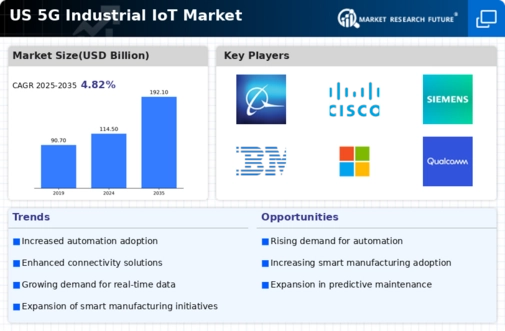Growing Demand for Automation
The increasing demand for automation in industrial processes is significantly influencing the 5g industrial-iot market. Companies are seeking to enhance productivity and reduce operational costs through automated solutions. The integration of 5G technology enables the deployment of advanced robotics and automated systems that require reliable and high-speed connectivity. In 2025, it is projected that the automation market in the US will reach approximately $200 billion, with a substantial portion attributed to 5G-enabled solutions. This trend suggests that industries such as manufacturing, logistics, and energy are likely to invest heavily in 5G technologies to support their automation initiatives. As a result, the 5g industrial-iot market is expected to experience accelerated growth driven by the push towards automation.
Increased Focus on Data Analytics
The emphasis on data analytics is emerging as a crucial driver for the 5g industrial-iot market. With the proliferation of IoT devices, industries are generating vast amounts of data that require sophisticated analytics for actionable insights. The integration of 5G technology enhances the ability to collect, transmit, and analyze data in real-time, thereby improving decision-making processes. In 2025, the data analytics market in the US is anticipated to surpass $70 billion, with a significant portion of this growth linked to 5G applications. This trend indicates that businesses are increasingly recognizing the value of data-driven strategies, which in turn fuels the demand for 5G solutions within the industrial sector. Consequently, the 5g industrial-iot market is likely to benefit from this growing focus on data analytics.
Regulatory Support for 5G Deployment
Regulatory support is a vital driver for the growth of the 5g industrial-iot market. The US government has been actively promoting the deployment of 5G technology through various initiatives and policies aimed at enhancing connectivity across industries. This support includes spectrum allocation and funding for infrastructure development, which facilitates the rapid rollout of 5G networks. As of 2025, it is estimated that federal and state investments in 5G infrastructure will reach approximately $30 billion, underscoring the commitment to fostering a conducive environment for technological advancement. Such regulatory measures are likely to encourage industries to adopt 5G solutions, thereby propelling the growth of the 5g industrial-iot market.
Advancements in Network Infrastructure
The evolution of network infrastructure is a pivotal driver for the 5g industrial-iot market. Enhanced connectivity capabilities, characterized by lower latency and higher data transfer rates, are being realized through the deployment of 5G technology. This advancement allows for real-time data processing and communication, which is essential for industrial applications. As of 2025, it is estimated that the investment in 5G infrastructure in the US will exceed $100 billion, reflecting a commitment to modernizing industrial operations. The integration of 5G with IoT devices facilitates seamless communication across various industrial sectors, thereby enhancing operational efficiency and productivity. Consequently, businesses are increasingly adopting 5G solutions to leverage these benefits, indicating a robust growth trajectory for the 5g industrial-iot market.
Rising Need for Enhanced Security Solutions
The increasing need for enhanced security solutions is becoming a prominent driver for the 5g industrial-iot market. As industries adopt more connected devices, the potential for cyber threats escalates, necessitating robust security measures. 5G technology offers advanced security features that can help mitigate these risks, such as improved encryption and authentication protocols. In 2025, the cybersecurity market in the US is projected to reach $200 billion, with a significant portion of this growth attributed to the need for securing 5G networks and IoT devices. This trend indicates that industries are prioritizing security in their digital transformation strategies, which is likely to drive the adoption of 5G solutions within the industrial sector, thereby benefiting the 5g industrial-iot market.























Leave a Comment